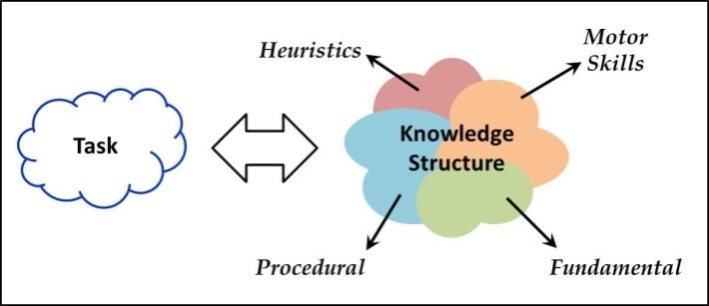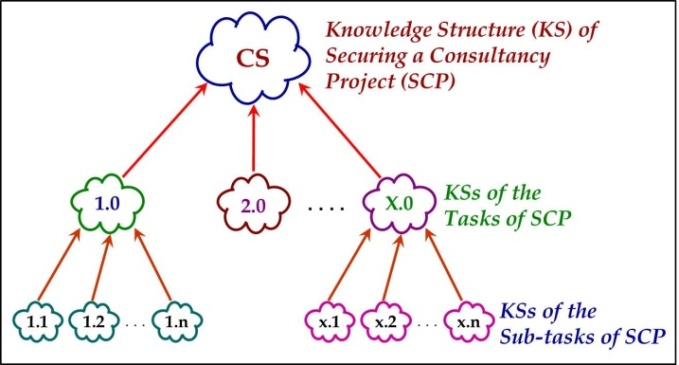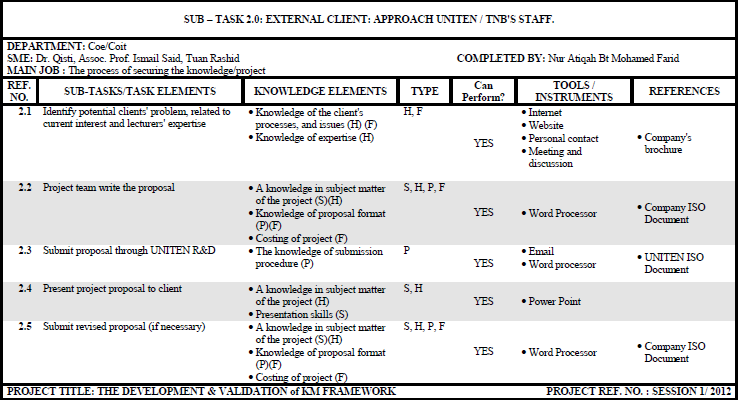-
Paper Information
- Next Paper
- Previous Paper
- Paper Submission
-
Journal Information
- About This Journal
- Editorial Board
- Current Issue
- Archive
- Author Guidelines
- Contact Us
Human Resource Management Research
p-ISSN: 2169-9607 e-ISSN: 2169-9666
2013; 3(1): 21-26
doi:10.5923/j.hrmr.20130301.05
The Capture and Analysis of Critical Knowledge in Consultancy Services Delivery: A Brainstorming Approach
Nur Atiqah Farid , Mohd Sharifuddin Ahmad
College of Graduate Studies, Universiti Tenaga Nasional, Malaysia
Correspondence to: Mohd Sharifuddin Ahmad , College of Graduate Studies, Universiti Tenaga Nasional, Malaysia.
| Email: |  |
Copyright © 2012 Scientific & Academic Publishing. All Rights Reserved.
In Universiti Tenaga Nasional (UNITEN), the Institute of Professional Advancement (INSPA) is established to be the platform for lecturers in offering their professional services. However, some aspects of the service delivery skills, knowledge and procedure are still unclear to the lecturers. From brainstorming sessions conducted with selected experts in UNITEN and a qualitative study of the ensuing results, we compile and capture the knowledge related to consultancy service delivery. In this paper, we discuss the process of knowledge capture using the brainstorming approach and present the results of the process.
Keywords: Consultancy, Knowledge Transfer and Sharing, Knowledge Capture, KM Framework
Cite this paper: Nur Atiqah Farid , Mohd Sharifuddin Ahmad , The Capture and Analysis of Critical Knowledge in Consultancy Services Delivery: A Brainstorming Approach, Human Resource Management Research, Vol. 3 No. 1, 2013, pp. 21-26. doi: 10.5923/j.hrmr.20130301.05.
Article Outline
1. Introduction
- As professionals in their area of expertise, lecturers are also required to offer consultancy service as a significant part of their responsibilities. In UNITEN, the Institute of Professional Advancement (INSPA) has been established to provide the platform for lecturers to offer their professional services. However, a study[1] conducted reveals that much more efforts are needed to improve the knowledge of these lecturers in conducting consultancy services and their visibility to external clients. Consequently, a sharing facility is required for lecturers to share their experience and knowledge in such services. In this paper, we propose and describe a technique for capturing the knowledge of consultancy services from a group of experts. Such knowledge could then be shared among the lecturers to close this knowledge gap.The literature provides ample information on the techniques of knowledge capture. Amongst those that we found include Brainstorming[2-3],[11-12],[15-16], Nominal Group Technique (NGT)[3],[10],[14],[16],Delphi[3],[6],[7-8],[16], Interview[4-5],[15-18] and Knowledge Acquisition and Documentation Structuring (KADS)[9],[15],[17-19]. From the analysis of these techniques and the nature of the consultancy knowledge, we decided to choose the brainstorming technique as part of our work to capture the knowledge of consultancy services delivery from a group of experts.In this knowledge capture process we used a two-stage approach, in which knowledge-based documentation (Kb-Doc) forms[1] are used to record two consultancy processes that are normally performed by lecturers: (i) The process of securing a consultancy project, and (ii) Implement an effective consulting operation from start until delivery of results.The paper is organized as follows: Section 2 discusses the related work of this research. In Section 3, we present in some details, the capture process of the knowledge of consultancy services delivery and the results of the capture process using the brainstorming approach. Section 4 concludes the paper.
2. Related Work
2.1. The Significant of Capturing Experts’ Knowledge
- Knowledge management recognizes and prioritizes the pre-requisite processes before proceeding to capture and map the required knowledge[23]. Knowledge capture is one of the components in knowledge management[24] that provides the benefits for company’s long term success and targets many perspectives such as[22-24]:• receive opinions and assurances from different experts related to the skills, procedure, routine’s aim, etc.,• recognize the weak points that exist in the routine for further improvement as well as enhancing intergroup synchronization and existing information,• create job opportunity that is valuable for future training and recruitment through the creation of knowledge inventory that has been captured from the experts,• visualize and recognize a process’s environment that influences the experts such as the process of consulting, the relationship between experts as group leaders with their clients and group members,• build a framework, diagram or flowchart to facilitate users in creating a temporary or long-term solution, how to perform the correct procedure, assist them on their actual/main target, recognize their risk’s factor as well as reduce severity,• help to recognize the compilation of knowledge and skills, and able to identify which type of knowledge that is valuable for staff in related domain or worthy of research investment, and• facilitate staff in providing training in different skills/tasks.
2.2. Approaches in Capturing Experts’ Knowledge
- The knowledge capture process not only captures knowledge but also the solutions that help experts in applying their knowledge for solving some problems[20-21]. NGT is used to describe a conceptual framework, workflow of business routine, allocating the knowledge needed that is significant in decision making, helps the company to make alterations in their routines that can be easily understood and adapt and to ensure that each individual has equal right in making the group decisions[3],[10],[14],[16].While in Delphi, once the problem is identified, questionnaires are distributed for feedback, results are shared with group members and the entire process is repeated with refinement until agreement is reached. This method is not conducted face to face[3],[6-8],[16].Brainstorming is known for a method of making decisions. It is aggressively conducted to push each member to contribute as many ideas as possible, while, one member of the group is assigned to record all the ideas. It is a method of seeking opinions from multiple experts and assists in generating ideas[2-3],[11-12],[15-16]. KADS allows users to identify prospective and bottom-up method on how companies establish, share and use their knowledge resources. It is conducted by analysing specific routines with the integration of knowledge[9],[15],[17-19]. Interview is a process that is systematically performed via face to face. It is a common and popular method in capturing information from respondents as well as from experts/stakeholders[15-18].
2.3. Comparison of Knowledge Capture Approaches
- There are several advantages and disadvantages that have been found regarding the five types of knowledge capture approaches. Table 1 compares the advantages and disadvantages.
|
3. The Knowledge Capture Process in Consultancy Services via Brainstorming
- One of the issues in knowledge capture is the determination of experts. In this paper, we shall not deliberate on this issue but suffice for us to state that in selecting the experts, we have considered the characteristics of the experts, e.g. their seniority and experience and the number of consultancy projects they have undertaken[2]. Consequently, for this project, we selected three subject matter experts (SMEs) from the College of Engineering (CoE), who fulfil these criteria. The knowledge capture process consists of two stages as shown in Figure 1. It shows the procedure that we apply to implement the knowledge capture process from the subject matter experts using the brainstorming technique.
 | Figure 1. The Knowledge Capture Process Utilizing the Brainstorming Technique |
3.1. Stage 1
- In this stage the SMES are requested to provide inputs to the following[2]: a) Identify each task of the consultancy process.b) Identify the importance, i, of the task. This is scaled and given points as follows:ⅰ. Very Important (VI) – indicates that the task is very important to analyze (3 points), ⅱ. Important (I) - the task is important to analyze (2 points),ⅲ. Less Important (LI) – the task is quite trivial (1 point). c) Identify the knowledge types, k, each task entails. Four types of knowledge are identified:ⅰ. Skills (S) – critical knowledge based on expertise (4 points),ⅱ. Heuristics (H) – knowledge based on previous experience(3 points),ⅲ. Procedural (P) – knowing the right steps to execute the task (2 points), andⅳ. Fundamental (F) – basic or pre-requisite knowledge that are required to understand the task (1 point).All the above findings are documented in Form I (Task Descriptions) of the Kb-Doc. At the end of Stage 1, an analysis is performed to determine if, for each task, further breakdown to sub-tasks is necessary to elicit further details about the task.To determine if the task needs further breakdown to sub-tasks, a simple formula is used as in equation (1):
 | (1) |
3.2. Stage 2
- In this stage, the SMEs are requested to perform the following[2]:a) Identify the sub-tasks for each task. The SMEs are guided to determine the granularity of the sub-task to avoid describing extensive details of the sub-tasks.b) Determine the knowledge types of each sub-task (S, H, P, or F), which should match the types identified in Stage 1. Otherwise the new knowledge types determined here are updated in Form 1. The knowledge description for each knowledge type is also determined. For example, if knowledge type identified is type F, then the knowledge is “Able to read the circuit diagram.”c) Identify the tools and references used to perform the sub-task.All the findings in this stage are documented in Form II (Skills and Knowledge) of Kb-Doc. While documenting the details of (b), a detailed analysis is required to create the knowledge structure of the sub-task.The knowledge structure of a task is the way in which the knowledge types (S, H, P, F) are built with which a set of actions is generated to perform the task. Figure 2 clearly describes a typical knowledge structure.
 | Figure 2. A Typical Knowledge Structure |
3.3. Creating the Knowledge Structure of a Sub-task
- The knowledge structure of a task is created by compiling the skills a task performer needs to have and the knowledge he needs to know in order to complete the task. For example, we show in Figure 3 below, a sample of a knowledge structure of a sub-task from the session:
 | Figure 3. A Sample of a Knowledge Structure (Form II) |
 | Figure 4. Abstractions of Knowledge Structures |
 | Figure 5. Kb-DocForm I: Main Task |
 | Figure 6. Kb-DocForm II: Sub-Task |
- We compiled the results of the brainstorming sessions, a sample of which is shown as the Appendix of this paper (see Figures 5 and 6). The results of the sessions were captured and analyzed using the MS-Excel (Version 2007) and the Brainstorming tool, XMind 2012 (Version 3.3.0).
4. Conclusions
- The brainstorming sessions were conducted with three selected lecturers who are experts in their main area which is engineering as well as the consultancy work which they have secured over many years as lecturers of UNITEN as part of their other responsibilities.The main objective of these sessions was to capture and identify the knowledge process, tools, references, level of importance, types of knowledge that are used by experts in delivering the consultancy services that might be useful for new or less experienced lecturers.From the brainstorming sessions, we discovered that there are several knowledge processes which are critical for sharing. These were documented in two forms of Kb-Doc; the first captures the main task and the second documents the sub-tasks.The complete results of the knowledge capture process are compiled into one complete Kb-Doc for reference and use of future generation of lecturers or consultants in UNITEN to deliver effective consultancy services to UNITEN’s clients. Further work will proceed by refining and finalizing the KM Consultancy Framework of which the Kb-Doc is a part.
ACKNOWLEDGEMENTS
- This study is supported by INSPA Director, INSPA Experts - Trainers and Consultants, and UNITEN Deans and Lecturers. We acknowledge and thank all those who have contributed data and information for this paper.
 Abstract
Abstract Reference
Reference Full-Text PDF
Full-Text PDF Full-text HTML
Full-text HTML